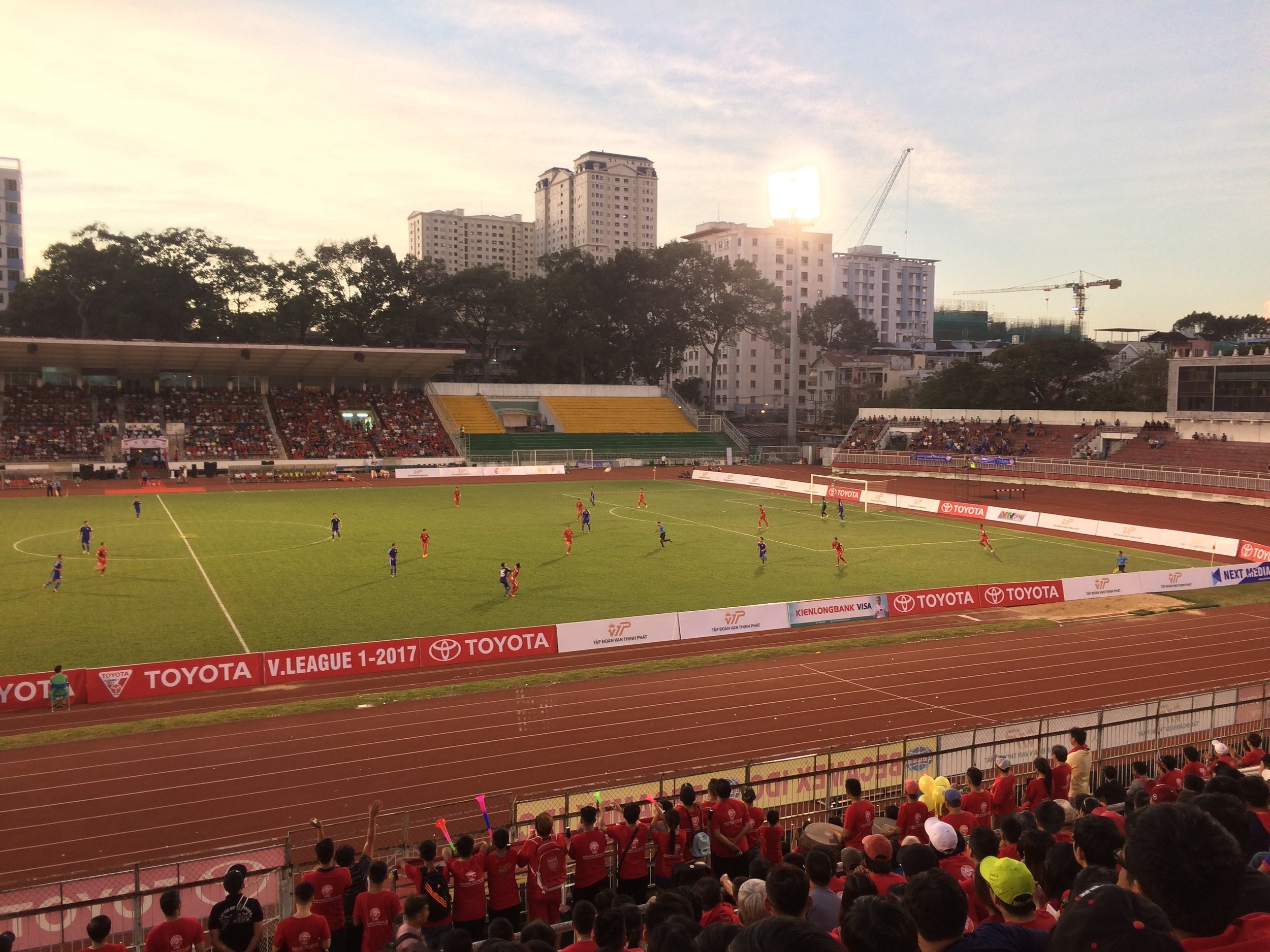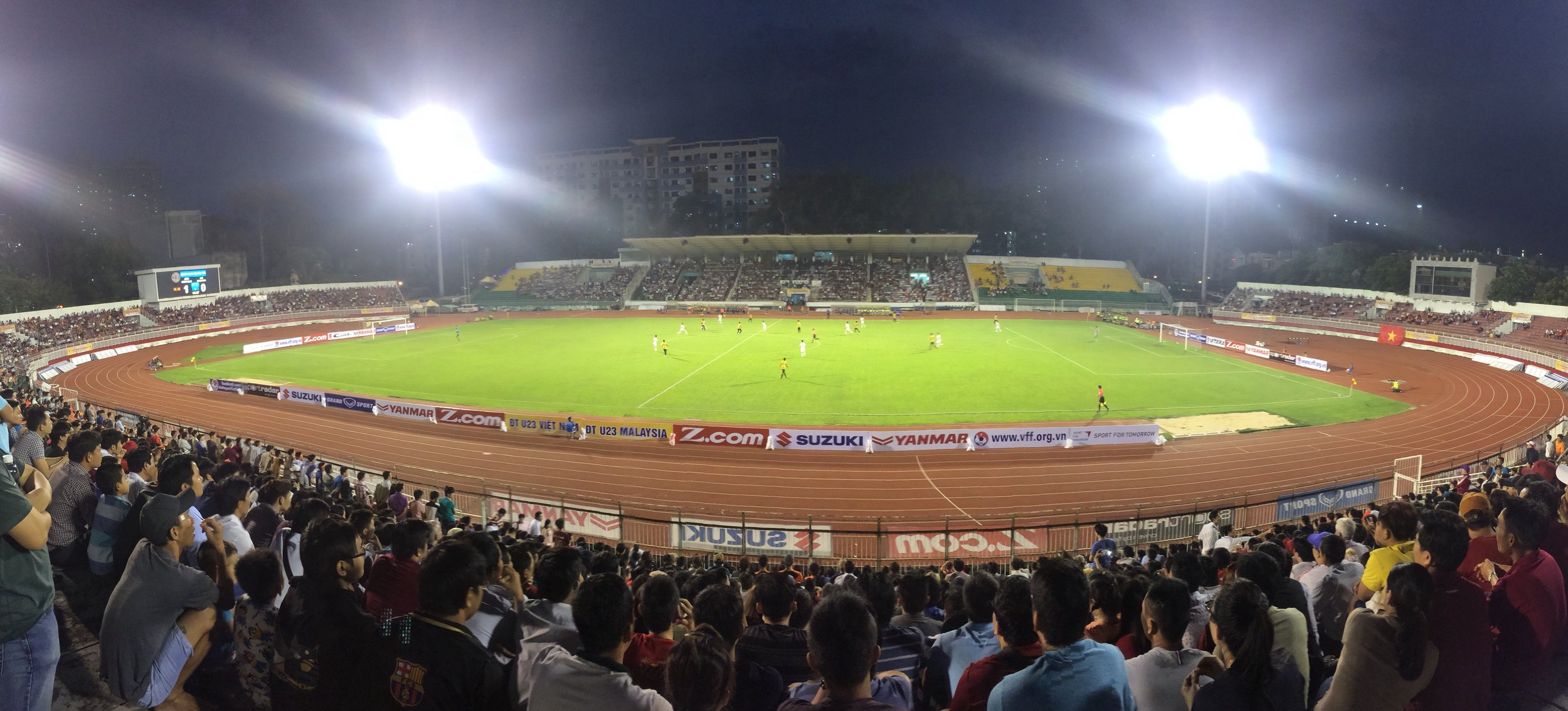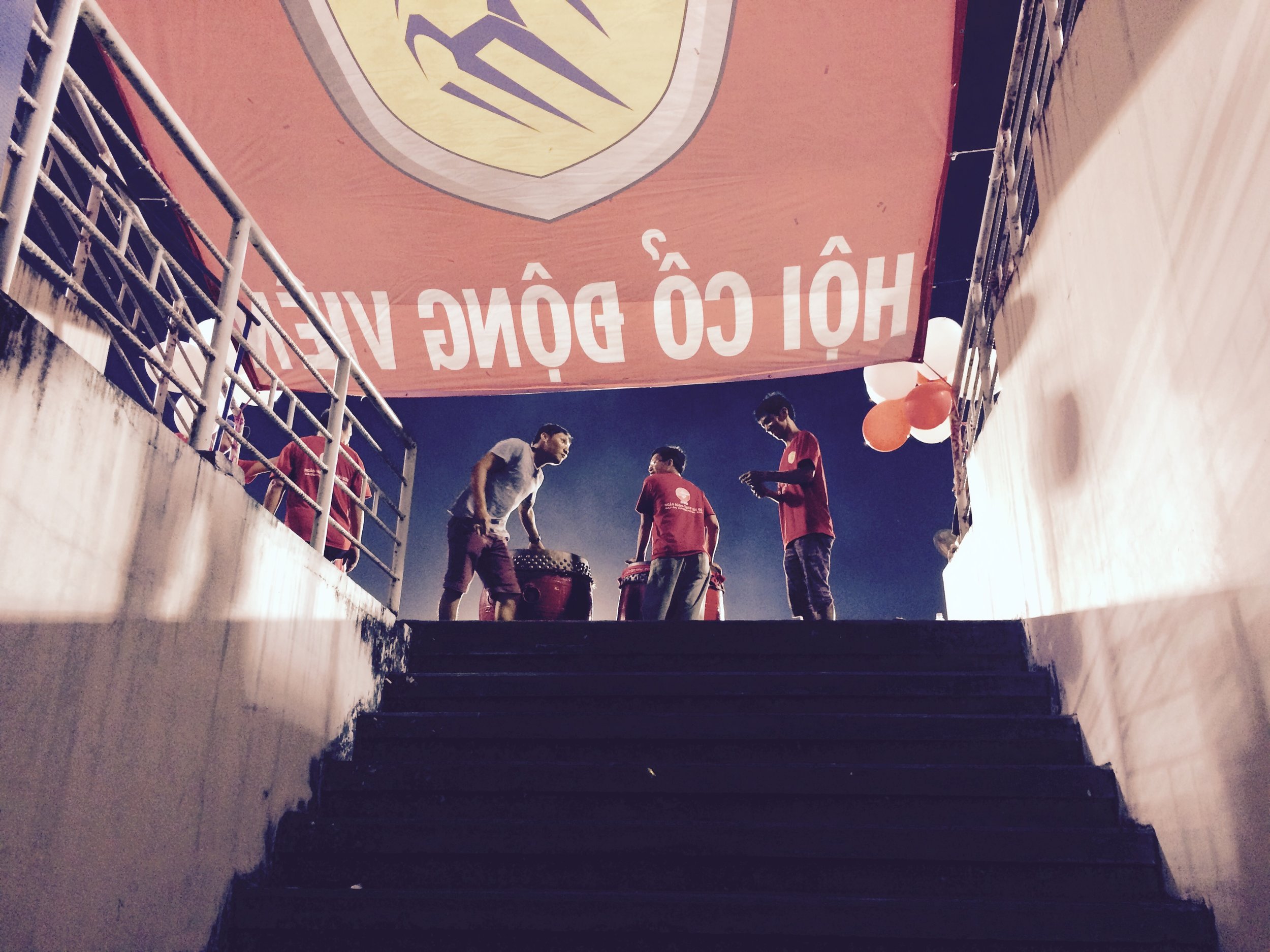VIETNAMESE FOOTBALL: AN IN-DEPTH ANALYSIS

Nothing could be more up our street than a 2,500-word in-depth analysis of Vietnamese football, the history of club football in Hanoi, and the arrival of franchise football in Vietnam. Welcome to IBWM Scott Sommerville...
The History Lesson
Club football has existed in both Hanoi and Ho Chi Minh City since the end of World War II. Clubs were formed from existing groups and organisations, primarily state-owned organisations; The Army, Hanoi Police, Saigon Port, Saigon Police, and the General Railways team all established themselves between 1950-1970. However, until reunification in 1976, these teams were limited to playing other teams in their local area – the teams in South Vietnam stuck to playing each other, and the Northern teams likewise. There was no crossover, the enemy were not to be approached, not even for a possible wallowing in victory – the potential of defeat was not worth the risk.
However, things were, and are changing. The unification of the country in 1976, followed by the 1986 cultural revolution of ‘Đổi Mới’, opened the doors to foreign investment, entertainment for the masses, and most of all, reliable electricity. With reliable power came television, and the internet. Since the country opened its doors to the world in the 1980s, football in this Socialist State slowly started to become more organised and more centralised, and the existing league (operating since 1980) continued to establish itself under the somewhat tennis-themed ‘All Vietnam Football Championship’.
After a lull in the 1990s, the top league in Vietnam turned professional in 2000, and with that change came commercialisation and sponsorship on a grand scale. Vietnamese clubs followed the examples set in South Korea and China by allowing sponsorship of team names; 2015 V.League 1 champions Becamex Bình Dương are sponsored by construction and development firm Becamex, Hanoi giants Hà Nội T&T (now simply Hà Nội FC) were formed with the investment of the T&T Group Trading Company, and central powerhouse SHB Đà Nẵng received financial backing from the Saigon-Hanoi-commercial Bank. Sponsorship extends to the league names too - the top league is the Toyota V.League 1, then follows the Kienlongbank V.League 2, and the semi-professional third tier, the Dong Luc Group Second Division. It all seems very un-communist.
On The Field
The question is… who do the ordinary Vietnamese people support? The majority - approximately 95%+ of football fans in Vietnam - support teams from all over the world, except, it would appear, teams actually in Vietnam. Real Madrid, Barcelona, Manchester United, and Liverpool have huge followings in Vietnam, with dedicated Facebook groups, organised game-watching events, and hundreds of thousands of replica shirts sold in the local markets. There is an undoubted love for football in Vietnam - foreign football.
There are a number of reasons for the preference of foreign football over domestic football. One of the main reasons is the quality of football; another, somewhat more succinct reason is that Vietnamese football clubs appear, and then disappear just as quickly. Reminiscent of every “new Messi” that appears in Argentina every season, clubs are disbanded and forgotten about in the blink of an eye.
One thing about Vietnamese football that strikes you is the number of clubs that have existed for over 30 years, before splitting into two teams, changing name, combining with other teams, or simply disappearing. In North Vietnam, Thể Công (Army Team) and Công An Hà Nội (Hanoi Police) ruled the landscape north of the 17th parallel, whilst in the south, AJS (Association de la Jeunesse Sportive), Hải Quan Sài Gòn F.C. (Saigon Customs), and Cảng Sài Gòn (Saigon Port) dominated pre-reunification South Vietnam. However, these clubs - at least their romantic names - can no longer be found in the V.League tables. However, dig a little deeper, and you can find remnants of these teams of years gone by, hidden behind the wall of sponsor names and rebadged and rebranded teams.
Local teams for the local fans
So, who to support? Easy, you may think – people born in Hanoi will support Hanoi FC, regardless of whoever now sponsors them, right? However, who are, and perversely, where is Hanoi FC?
In 1956, Công An Hà Nội (Hanoi Police FC) were formed and competed in top flight Vietnamese football under the name Hà Nội FC until 2001, when they renamed as Hàng Không Việt Nam (Vietnam Aviation) for one season.
Meanwhile, also in 1956, CLB Tổng cục Đường sắt (General Railway FC) were formed, later renaming to Đường sắt Việt Nam (Vietnam Railway FC) in 1989. In 2000, the club received investment from ACB Bank and became ACB FC, forming a base in Hanoi.
...Stay with me.
2002 saw both clubs - Vietnam Aviation FC and ACB FC - merge, with additional sponsorship from LG to form LG.Hà Nội.ACB. In 2006, LG ceased their sponsorship, and the club was renamed Hà Nội ACB. Erstwhile, back in 2002, during said merger, a number of staff and players who were never selected for the new club formed a breakaway club, Hòa Phát Hà Nội FC, in the lower leagues of Vietnamese football.
The first club continued as Hà Nội ACB until 2011, when the club finished in last position in the league and found themselves facing relegation to V.League 2. In the same season, Hòa Phát Hà Nội FC (who had been promoted to V.League 1 a few season previous) had finished 10th and ensured survival. Not wanting to face relegation, Hà Nội ACB owners bought Hòa Phát Hà Nội FC and created two new clubs - Hà Nội FC competing in V.League 1 and Trẻ Hà Nội FC (Young Hanoi FC) competing in V.League 2.
At the end of 2012, after just one season (Hanoi FC finishing 9th in V.League 1 and Young Hanoi FC finishing 11th in V.League 2), the owner of the club was arrested on corruption charges and both clubs were immediately dissolved, with the players and staff left to find new clubs, new jobs, and new homes.
Elsewhere in Hanoi…
In 1954, one of Vietnam’s most successful and famous football teams was formed in Hanoi, Thể Công (Army Sports Team). The club won 13 North Vietnam titles, as well as five unified national league championships, making them the most successful team in Vietnamese football history, and the pride of the Vietnamese Military. After the turn of the century, and the continued professionalisation of the league – the Army Team struggled on and off the pitch – the team lacked a local community identity, and struggled with the commercial aspects of the game – after all, the team were literally The Army Team; they were the embodiment of the military sports complex and were not overly interested in commercial sponsorships.
In 2004, the team were relegated for the first time to the second tier of Vietnamese football, V.League 2. It was this relegation that led the team to reflect, both on and off the pitch; the club subsequently received their first sponsorship agreement in 2005, coincidentally enough from Viettel, the military-owned, largest Telecommunication company in Vietnam, and thus became Thể Công Viettel. The club was promoted back to V.League 1 two years later, and competed as Thể Công until 2010, when the Ministry decided to transfer all rights to Viettel.
Rather than keep a team in V.League 1, Viettel sold their league status to a team that would have otherwise been relegated, Lam Sơn Thanh Hóa, and transferred a large number of senior players to them. Having sold their V.League 1 status, Viettel competed in V.League 2 with a much younger team, finishing 9th in 2010, and also created a youth team to compete in non-league football. However, that wouldn’t be the end of the changes...
In the monsoon season of 2006, a new club was formed with the financial clout and sponsorship of T&T Group, a large Hanoi-based trading company. Hà Nội T&T started in the fourth tier of Vietnamese football, but thanks to sizeable investment, the club achieved three straight promotions and were competing in the V.League 1 by 2009. They finished 4th in their first season in the top flight, and have remained in the V.League 1 since. At the end of 2010, Hà Nội T&T purchased Viettel FC’s youth team and established Trẻ Hà Nội T&T (Young Hanoi T&T) playing in V.League 2. In 2013, this Young Hanoi T&T team was sold to an independent company and renamed Hà Nội FC. In 2016, this Hanoi FC team was again sold and relocated to Ho Chi Minh City and renamed Sài Gòn FC.
Who are ya?…Who are we?
And so to today. Ho Chi Minh City, the commercial capital of Vietnam boasting a population of 8.2m people, has again got two top flight football teams: Thành phố Hồ Chí Minh FC, and its new second team, Saigon FC - formerly Hanoi F.C., formerly Young Hanoi T&T, formerly Viettel FC, formerly ‘The Cong’m and now representing the bustling second city of Vietnam. In its first season, the new club, keeping the famous pink jerseys of Hanoi F.C., contained a squad of 26 Vietnamese players (plus two foreigners), most of whom come from the north of Vietnam.
Despite the reunification of Vietnam in 1976, the relationship between the governmental stronghold of Hanoi, and the buzzing, modernity-chasing Ho Chi Minh City is still a fractious one. Even on a social level, there is a deep distrust between the Người Bắc (northerners) and the Người Nam (southerners); Generation X were raised to hold the other as inferior and sympathetic of the enemy (whether that enemy be China or America). Fortunately, the most recent generation are moving on from this archaic stereotyping – the young professionals of today see the value in work ethic, creativity, and personality more so than where one happened to be born. Without this progress, the new Saigon FC would never have been able to up sticks and move the 1,004 miles from Hang Day stadium, Hanoi, to Thong Nhat stadium in downtown Ho Chi Minh City.
There wasn’t a media fanfare, TV was not abuzz with the new team arriving in the city – rather it was all a little under the radar, and the club was allowed to assimilate on its own terms. Some have speculated that perhaps the lack of attention was to hide any potential embarrassing first home game attendance, or that the VPF (Vietnam Professional Football) were keen to downplay the fact that a team was allowed to move cities, stadiums, and players halfway through the ongoing season. However, the 80-strong security team on duty for the first home game were slightly overwhelmed, as slowly but surely the stadium began to fill; 15 minutes before kick-off, some 3,000 fans had taken their seats on the red-hot concrete terraces. They kept coming. For the next 20 minutes, the flow of young people continued, and the stands slowly swelled. After the first chance had fallen to the day’s opposition, Quang Nam FC, some 8,000 fans had found their way into the ground – all smiling, all happy, wanting to see a new team.
Franchise Football – One Year On
Anyone who watches football regularly in Vietnam, or any other developing nation, will tell you that it’s hard to keep the fans interested, and keep them coming through the turnstiles week-in, week-out.
12 months after the decision to move Hanoi FC 1,000 miles south, and to change the name to Saigon FC, things are not looking as bright as they were. Despite having a modern, forward-thinking social media team, Saigon FC have struggled to find a fanbase. That first game hosted some 8,000 fans, interested to see this new team, wanting to be entertained, desperate to be entertained. In the final game before the mid-season break, Saigon hosted Quang Nam at Thong Nhat Stadium knowing that a victory would take them joint top of the table. The attendance was reported in most places as 350; however, that may have been an exaggeration.
From matchday 1 to matchday 13, the attendances for Saigon FC were dwindling by the game, despite the hired cheerleaders, because the fans simply were not interested anymore. The new team buzz had evaporated. The other team in the city, the well-established Ho Chi Minh City FC (formerly Saigon Port), also saw attendees slowly drop during the season; however, they dropped from 5,000 to around 3,500, primarily due to the team having only just gained promotion the season before, and having a somewhat mediocre season.
Despite the very poor attendances for Saigon FC, Vietnamese football websites and many dedicated Facebook football groups remain staunchly quiet on the issue. There is a notable absence of concern regarding the financial viability of the club, or the success of the move in the grander scheme of things – perhaps, ignorance is bliss. Perhaps, if it isn’t discussed, it isn’t a problem – this is certainly an approach that the VFF and VPF would adopt. This writer, however, is concerned. The owners are reportedly a wealthy group of businessmen; however, there is only so much money one is prepared to lose before interest begins to wane. If attendances in the second half of the season do not improve – and the prediction is bleak – we have seen football clubs disbanded overnight in Vietnam, and it will happen again. Poorly paid players and staff will once again be left without a club, desperate to find employment, on or off the field.
Every Cloud
If, and it still is an ‘if’, Project Saigon FC does fail, perhaps this will finally be the message that the governing bodies need; franchise football does not work. Football clubs represent a community, a village, town or city. They are not organisations that can be picked up and moved around the map in order to fill holes – they are clubs generated from the bottom up, groups of like-minded locals who band together to form and watch their local team. Ho Chi Minh City is the most populous city in Vietnam, there is certainly room for more than one top flight team – if the VFF or VPF are adamant in having more teams, then invest in the teams that already play in the city, invest in the teams who already have a community around them, a fan base wanting to support their team, regardless of results.
By Scott Sommerville.




